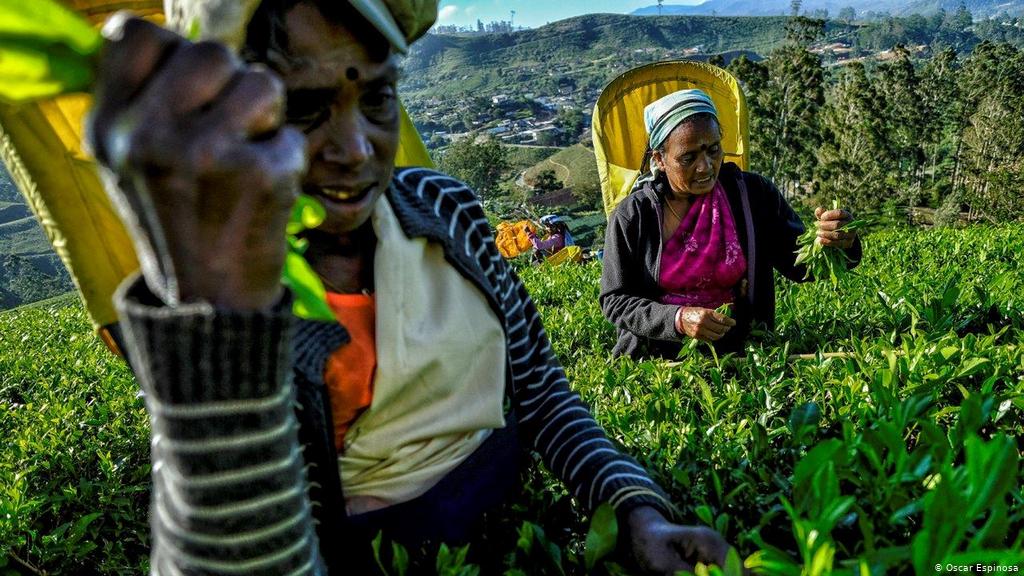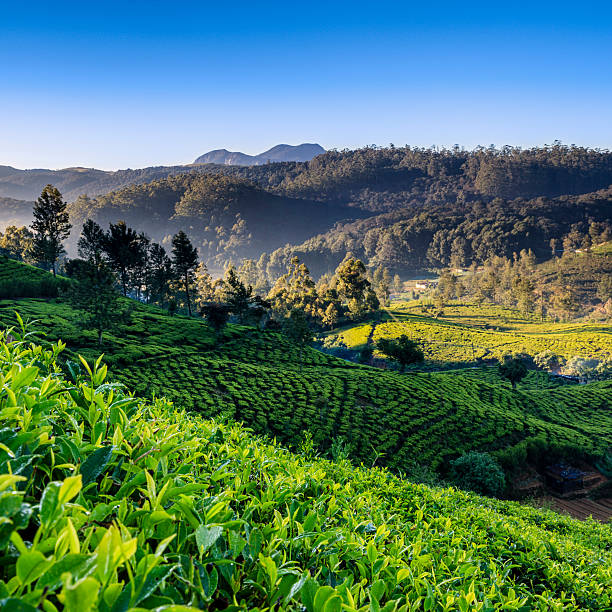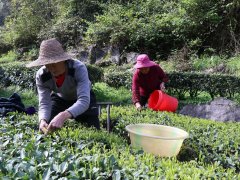Differences in the characteristics of black tea from highland, middle and lowland in Sri Lanka
Climbing the mountain road with nine curves and eighteen bends by bus, the side of the road is densely planted with black tea trees as high as car windows, so close that you can almost pick fresh tea with your hand out. On the other side, it is a chilling deep valley. Falling down a steep hillside will definitely cause a big deal, but it is also covered with tea trees. The soil is red, and the soil washed out when it rains dyes the road beautifully red, and the red lines in the green look like blood vessels.
The island of Sri Lanka is shaped like papaya and rugby. The island is divided horizontally into four parts, the lowest of which is the area where black tea is grown. The remaining three-quarters of the country is basically tropical rain forests and savanna areas, there are no high mountains or mountains, it is not suitable to grow tea trees that prefer mountain areas.

In the center of the southwest of the island, there are mountains up to 2000 meters above sea level, and the area facing the Indian Ocean and the mountains facing the Bay of Bengal are dotted with black tea plantations. Black tea plantations are divided into broad areas known as six black tea producing areas, each with its own altitude to form its own flavor, tea aroma and water color characteristics, and take this as a selling point.
For example, no matter what kind of plant is cultivated in flat land, its size and fragrance will be completely different from that in mountain areas. When tea is planted in low-altitude and high-altitude areas, its astringency, tea aroma and water color will also change. Each area is divided one by one according to the altitude of every 600 meters, publicizing the characteristics of black tea at each level.
Lowland tea
Lowland tea (Low Grown) is planted between 0,600m and 1200m, Middle Grown between 600m and 1200m, and High Grown between 1200m and 1800m.
One of the most famous lowland teas is Luhuna black tea made in the province of Sabaragamuwa. Because this is the lowland, the tea garden is also planted with papaya, bananas and coconut trees, which is reminiscent of the green tea garden of the rainforest and muggy because of the high temperature and humidity. The tea grows well, the leaf shape is large, and the leaf bud part will grow to 2cm, thick and large, while the silver tip and golden tip tea made from only the leaf bud will be sold at a high price.

The origin is slightly higher above sea level, but the same lowland tea is Kandi black tea, which comes from the central province with the ancient capital Kandi as the center. The local climate is stable, less affected by the monsoon, and the black tea produced is highly transparent, characterized by the unique taste and aroma of black tea, and is often regarded as the basis of Ceylon black tea model.
Zhongdi tea
As the representative of the Zhongdi Tea Plantation is located in the northwest Timbra region. There is a small village called Timbra, where Timbra black tea was born. This is the mountainous area facing the Indian Ocean. After the monsoon blowing from the Bay of Bengal from January to February crosses the mountains and forms a dry and cold wind, black tea with high quality and outstanding personality can be made.
Highland tea
Highland tea is written as High Grown Tea. From the word "High", it is easy to be misunderstood as high quality, high price or high quality, but here it only refers to the height of the highland, which is not directly related to quality. The drastic temperature changes in the highlands, coupled with the influence of fog, light rain, strong wind and cold wind, will produce a strong aroma and astringency of tea, resulting in the birth of black tea, which is particularly prominent in three elements.

Typical of these is Nuwara Eliya, where tea is grown as high as 1850 meters above sea level. Equivalent to this is the Uda Pussellawa area, which happens to be located on both sides of the mountain, separated by the top left and right. The two places are the first to be affected by the monsoon from the Indian Ocean and the Bay of Bengal, producing high-quality seasonal black tea.
As a highland tea-producing area, the three most famous teas in the world come from the mountains facing the Bay of Bengal, and the wind blowing from the Indian Ocean from July to August is blocked by the mountains. This cold and dry wind gives the tea a unique refreshing aroma and irritating astringency, and the high-quality seasonal Wuwo tea will be traded at a high price.
The six major black tea producing areas have more than 600 tea gardens. With the black tea factory as the center, people who work in the tea garden live here, forming a village organization in which the workshop head serves as the village head. The tea garden is also equipped with facilities such as schools, clinics, monasteries and assembly places, and sports meetings and festival ceremonies are held from time to time.
Important Notice :
前街咖啡 FrontStreet Coffee has moved to new addredd:
FrontStreet Coffee Address: 315,Donghua East Road,GuangZhou
Tel:020 38364473
- Prev

When is the best time to pick tea? what month is the best tea quality and the best picking schedule for one year?
Taiwan tea picking schedule (seasonality of tea) the seasonality of tea is very important. There are four tea seasons in Taiwan. The weather in Taiwan is almost perfect for the production of oolong tea, where tea merchants produce famous oolong teas with different shapes, styles and tastes. In Taiwan, the nature and size of leaves change with the passage of season, although a kind of tea has been completed today.
- Next
How to drink black tea correctly? Beginners choose suitable tea from brown color, tea aroma and tea taste.
How would you like your black tea? Seemingly ridiculous problems, but they have their own exquisite and reasonable among them. Of course, I don't want to teach the professional taste method of sucking and gargling and using all kinds of evaluation terms here at all. For me, black tea is the joy of daily life, relaxed and leisurely, is the real way to wander. But in the process of enjoying every detail, if you can always pay attention to every subtle change
Related
- What is the difference between a cake filter cup and a V60 conical filter cup? What are the advantages and disadvantages of the flat-bottomed filter cup brewing solution?
- What is the difference between fine coffee powder and medium coarse coffee powder? Do I need to sift out the fine coffee powder for making coffee by hand?
- Why does hot American coffee taste bitter? Difference in proportional concentration between hot American and ice American
- Is espresso stored overnight in the refrigerator harmful to your body? Is frozen coffee better than freshly ground coffee?
- What parameters and proportions of water temperature should be used to grind and brew fresh coffee beans? Why can't I drink freshly roasted coffee right away?
- Customers have "changed" Manner's new products! Shop assistant: Please don't mess around!
- Remove sockets in customer areas at Starbucks stores?! Netizen: I won't go if I really tear it down
- What is the difference between the taste steps of sun-dried coffee and washed coffee? Why is sun-cured coffee sweeter and washed coffee sour?
- The recipe for salty grapefruit dirty is revealed! Coffee Festival salty grapefruit dirty coffee making materials parameters ratio milk share!
- How about the flavor of Sunlight 74158 at Sidamo Banshaha Mathieu Processing Factory in Ethiopia? 74158 Share the proportion of coffee brewing parameters!

